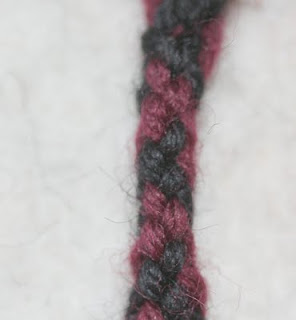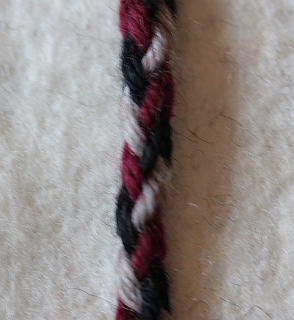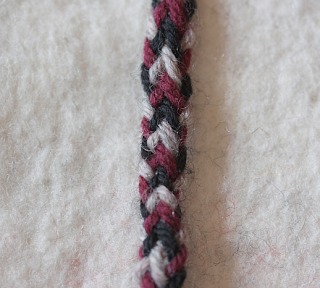During the Forum week, we of course chatted about all kinds of things (though most of them fibre-related), and of course there were requests to share this or that link or site.
So here's the Brain Test, my part - let's see if I can remember what I was supposed to.
First of all, of course, there's Phiala's String Page (where I made my first braiding steps many years ago) and where the now-famed and coveted pdf about tablet weave structures may be found. The accompanying talk lit quite a few lightbulbs in tablet weavers' heads!
There's a video on Youtube I talked about - no, wait, there's more. First there are the two wonderful and calming videos showing short-draw and long-draw spinning by Ruth MacGregor that I linked already here. (At the Forum, I had the joy of getting taught long-draw by Ruth herself. I can now spin thick and fluffy yarn, hooray and huzzah! And Ruth in person is even more calm and friendly than her videos suggest.) Then there's the incredibly speedy weaving on an inkle loom, to be found here.
Then there was mention of the Tsarina of Tsocks. If anyone can tempt me to add knitting to my stash of textile techniques, it is her with her incredibly beautiful socks! There's also a blog where she writes about tsocks (who would have guessed?)
Another thing I frequently mentioned to several persons (mainly day-guests and visitors, though) is Therèse de Dillmont's book. If you have not yet found out about it, go visit the webpage where the whole book (in the English version) is available for free!
Oh, and I am also supposed to put up pictures of the event (and the spinning) on the Textilforum website, send around the list of adresses of the participants and analyse and evaluate the data from the experiment. Which will all happen, and soon.
So here's the Brain Test, my part - let's see if I can remember what I was supposed to.
First of all, of course, there's Phiala's String Page (where I made my first braiding steps many years ago) and where the now-famed and coveted pdf about tablet weave structures may be found. The accompanying talk lit quite a few lightbulbs in tablet weavers' heads!
There's a video on Youtube I talked about - no, wait, there's more. First there are the two wonderful and calming videos showing short-draw and long-draw spinning by Ruth MacGregor that I linked already here. (At the Forum, I had the joy of getting taught long-draw by Ruth herself. I can now spin thick and fluffy yarn, hooray and huzzah! And Ruth in person is even more calm and friendly than her videos suggest.) Then there's the incredibly speedy weaving on an inkle loom, to be found here.
Then there was mention of the Tsarina of Tsocks. If anyone can tempt me to add knitting to my stash of textile techniques, it is her with her incredibly beautiful socks! There's also a blog where she writes about tsocks (who would have guessed?)
Another thing I frequently mentioned to several persons (mainly day-guests and visitors, though) is Therèse de Dillmont's book. If you have not yet found out about it, go visit the webpage where the whole book (in the English version) is available for free!
Oh, and I am also supposed to put up pictures of the event (and the spinning) on the Textilforum website, send around the list of adresses of the participants and analyse and evaluate the data from the experiment. Which will all happen, and soon.








